 Family: Colubridae
Family: ColubridaeSubfamily: Colubrinae
Genus: Boiga (Cat Snakes)
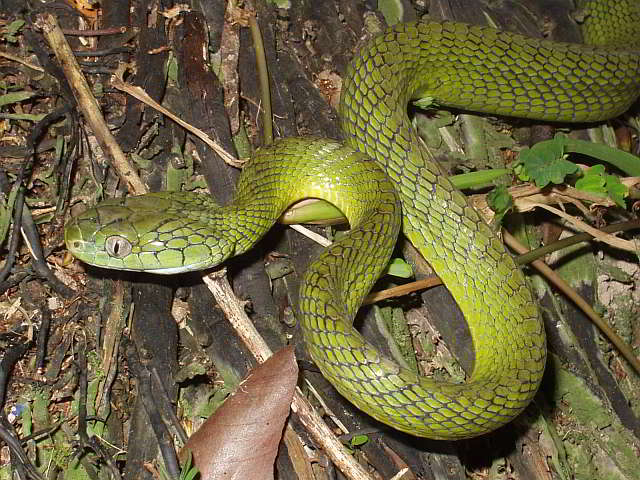
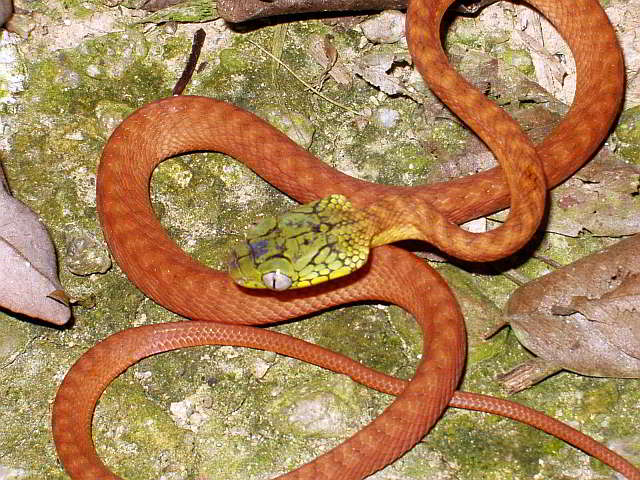
Fotos: J. Bulian - juvenile snake-
 Boiga cyanea (Green Cat Snake)
Boiga cyanea (Green Cat Snake)Thai:
 (ngu kio bon)
(ngu kio bon)Length: Up to 186 cm
Distribution area: Whole of Thailand. The snake is, however, more common in southern Thailand than in northern or central Thailand.
Behaviour/habitat: Boiga cyanea is mainly found in the flat lands. They live in bushes and trees in woods and plantations. These snakes are nocturnal. Young animals are orange/red in colour. The colour changes into brown and then green after approx. ½ year. The animals feed themselves mainly on lizards, frogs, rodents and birds. Other snakes are also eaten on occasion.
Danger level: The Boiga species is a rearfanged snake. At least one case of poisoning has been recorded in literature. The snake can, however, be counted as harmless for humans as they are not very aggressive.
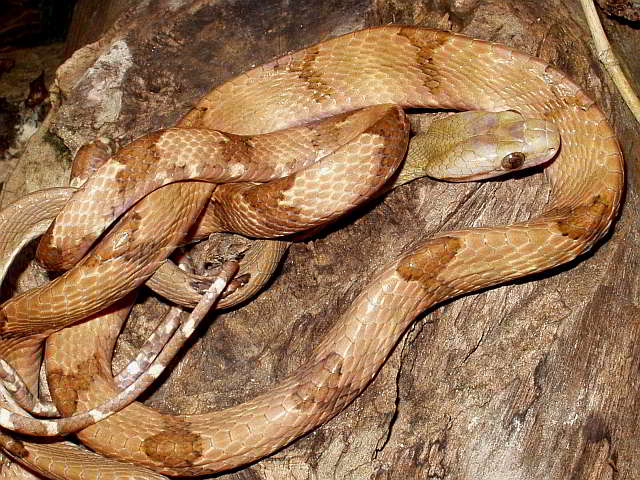
Picture: J. Bulian
 Boiga cynodon (Dog-toothed Cat Snake)
Boiga cynodon (Dog-toothed Cat Snake)Thai:
 (ngu sae hang ma)
(ngu sae hang ma)Length: Up to 275 cm
Distribution area: In southern Thailand from Pratchuap Khiri Kahn.
Behaviour/habitat: The Dog-tooth Cat Snake lives mainly in the trees of lowland rain forests. You will hardly ever meet the snake in cultivated areas or near to human settlements. An exception is poultry farms as the Boiga Cynodon feeds itself almost exclusively on birds and their eggs (also chickens). This species is active at twilight and at night.
Danger level: Even when attacked, these snakes generally do not bite. If it does come to a poisoning bite, swelling and pain will be felt in the wound area. It can lead to circulation problems. However, this only happens if the snake bites powerfully and massages its venomous into the wound. A self-defence bite is not dangerous.

Picture: J. Bulian
 Boiga dendrophila melanota (Banded Mangrove Snake, Yellow ringed Cat Snake)
Boiga dendrophila melanota (Banded Mangrove Snake, Yellow ringed Cat Snake)Thai:
 (ngu plong tong)
(ngu plong tong)Length: Up to 250 cm. In Thailand, the animals normally only reach a length of approx. 2 meters.
Distribution area: The Boiga dendrophila is only to be found in Southern Thailand.
Behaviour/habitat: The snake resides in rain and mangrove forests. It is mostly found near rivers, brooks, ponds and swamps. This species is nocturnal. The snake feeds almost everything they can catch, including other snakes. If aggravated, the snake makes itself into an S shape, flattens out the front of its body and opens its mouth wide, so that the black inside of the mouth can be seen. The snakes are easily provoked and bite very quickly.
Danger level: The danger of poisoning is almost non-existent. Only due to size and the aggression of the animals, can it lead to strong bleeding and painful wounds if bitten. Medium venomous, sometimes strong local poisonings!
Not - Danger of mistake with:
● Bungarus fasciatus (Krait) venomous!
● Lycodon laoensis
● Dryocalamus
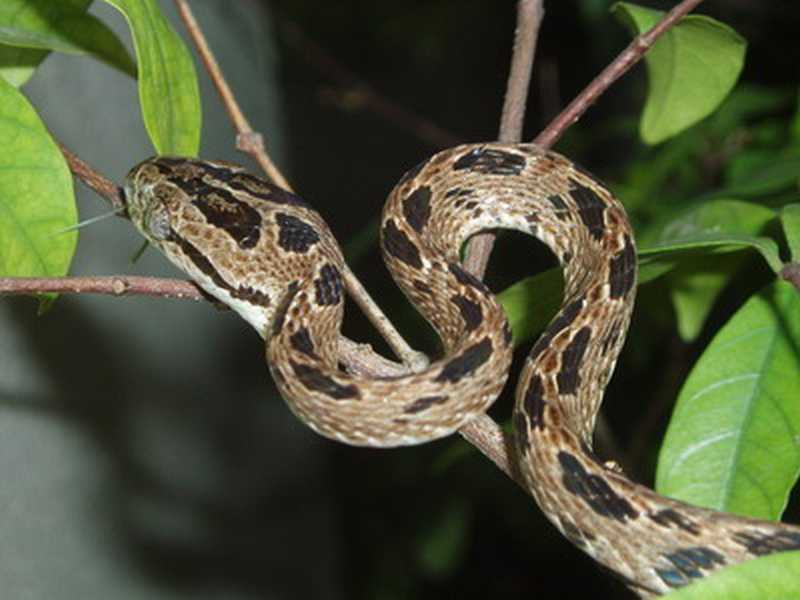
Picture: J. Bulian
 Boiga multomaculata (Many-spotted Cat Snake)
Boiga multomaculata (Many-spotted Cat Snake)Thai:
 (ngu me ta ngao rang nok)
(ngu me ta ngao rang nok)Length: Up to 187 cm. However, most of these animals only reach a length of around 140 cm.
Distribution area: North, east and central Thailand. In southern Thailand it can be found up to around Hua Hin. Further occurrence in southern Thailand is not determined.
Behaviour/habitat:
A resident of trees and bushes in the lowlands and mountains. These snakes are relatively calm. They usually only eat lizards.
Danger level: There is no known venom effect on humans.
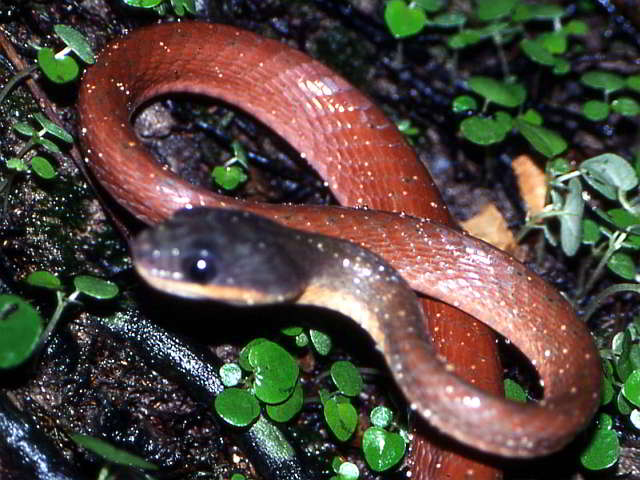
Picture: J. Bulian
 Boiga nigriceps (Red Cat Snake)
Boiga nigriceps (Red Cat Snake)Thai:
 (ngu tong fei)
(ngu tong fei)Length: Boiga nigriceps reaches a length of up to 175 cm.
Distribution area: The Boiga nigriceps is only to be found in the extreme south of Thailand.
Behaviour/habitat: The snake is nocturnal. It lives in the bushes and trees of primary and secondary forests. It eats rodents, frogs and lizards. They are similar to the Boiga cyanea in their behaviour.
Danger level: The Boiga species is a rear fanged snake. The snake cannot generally be counted as dangerous to humans , because they are not very aggressive. However, a few cases of intoxinating are known of. You should, however, note that some people are even allergic to bee stings. For this reason, you should not over estimate the toxic effect of a Boiga bite.
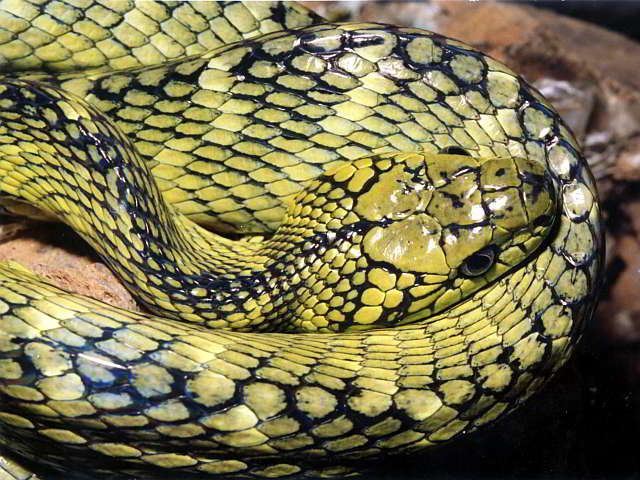
Picture: J. Bulian
 Boiga saengsomi (Banded Green Cat Snake)
Boiga saengsomi (Banded Green Cat Snake)Thai:
 (ngu kieo dong lai)
(ngu kieo dong lai)Size: Up to 220 cm
Distribution area: In Amphoe Sikao in Trang province and most probably in other districts of the province. This species also seems to habitat in the province of Krabi (Amphoe Khao Phanom). This snake lives in trees and usually lives at heights over 250m above sea level. The last sighting was in 1985.
Danger level: The snake belongs to the rear fanged snake family. A bite is only dangerous if the snake bites and hangs onto the skin and is allowed to chew the venom into the wound for several minutes. It is otherwise harmless.
Wanted: If you should have seen this snake or if you have any proof of its occurrence, then send please an e-mail to Joachim Bulian in Suratthani, Thailand jo_bulian@yahoo.de or give him a quick call on 0862816661 (Thailand mobile phone)
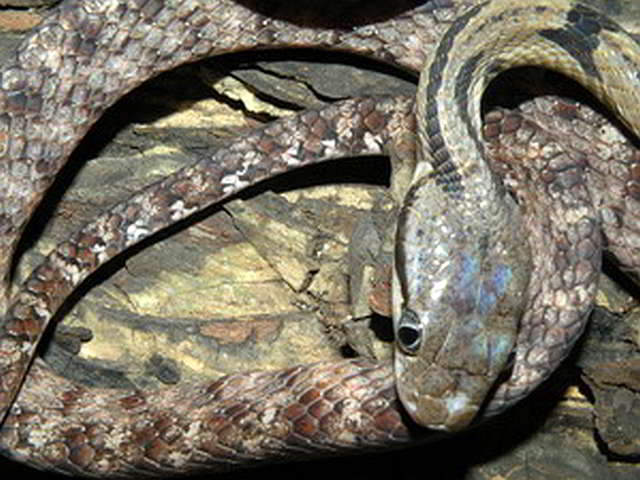
Picture: J. Bulian
 Boiga siamensis (Grey banded Cat Snake)
Boiga siamensis (Grey banded Cat Snake)Length: Males up to 200 cm, females 240 cm
Distribution area: North of the Isthmus of Kra.
Habitat/habitat: Boiga siamensis inhabits the forests up to 1780 m. This snake is activ during the night. About live, food and reproduction in the wild are no data availible. In captivity Boiga samensis feeds on rodents ( mice and rats) and chicklets. In the wild the sanke probabely feeds mainly on birds and their eggs.
Danger: Boiga siamensis belongs to the rear fanged snakes In the back of the upper jaws are three elongated grooved fangs A normal bite should be not dangerous to humans as long as the snake does not hold on and chews the poison in the wound.
Mildly-venomous/non-venomous snakes of Thailand
Venomous snakes of Thailand
≡ Menu
All data is provided without guarantee!